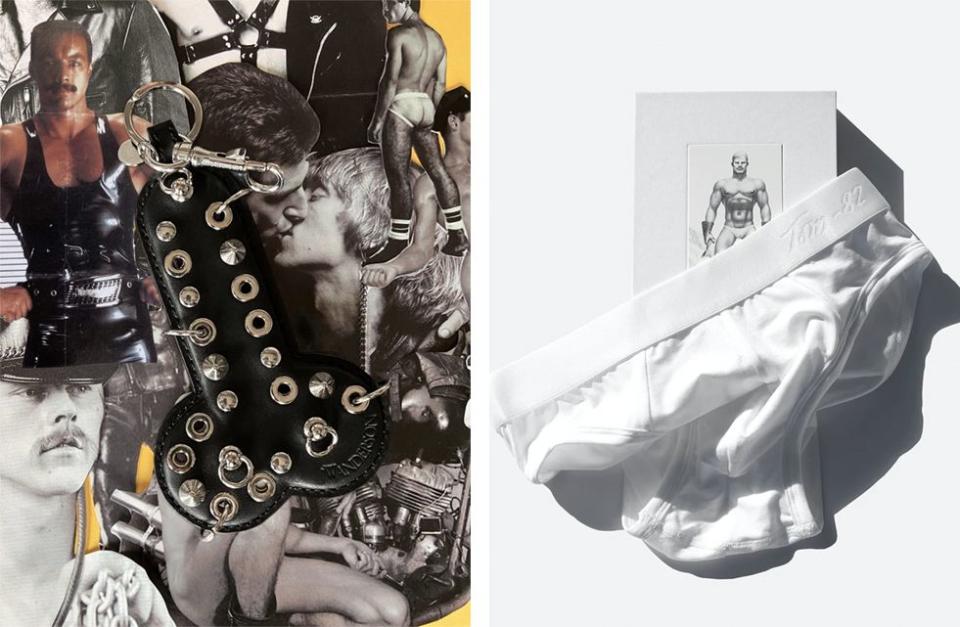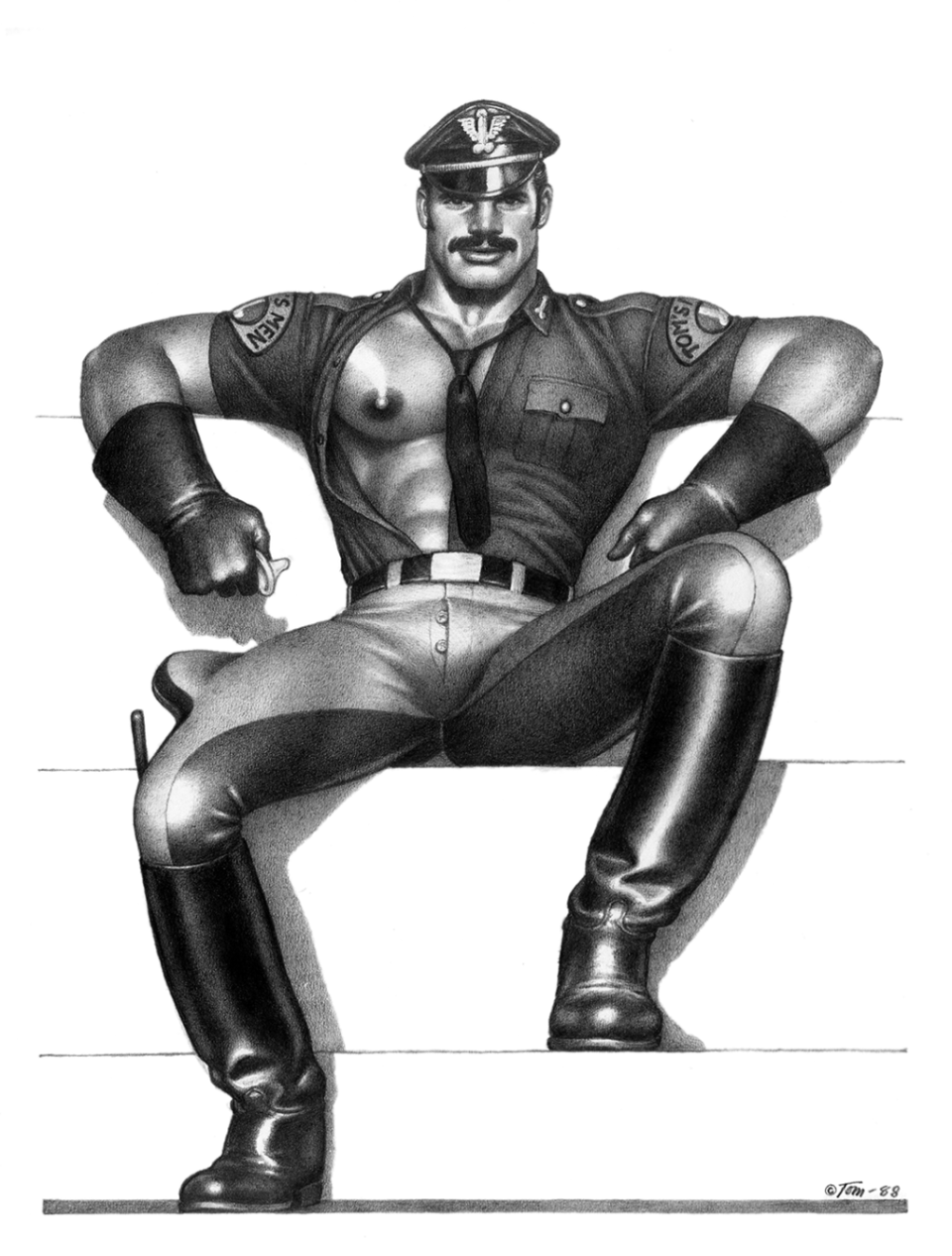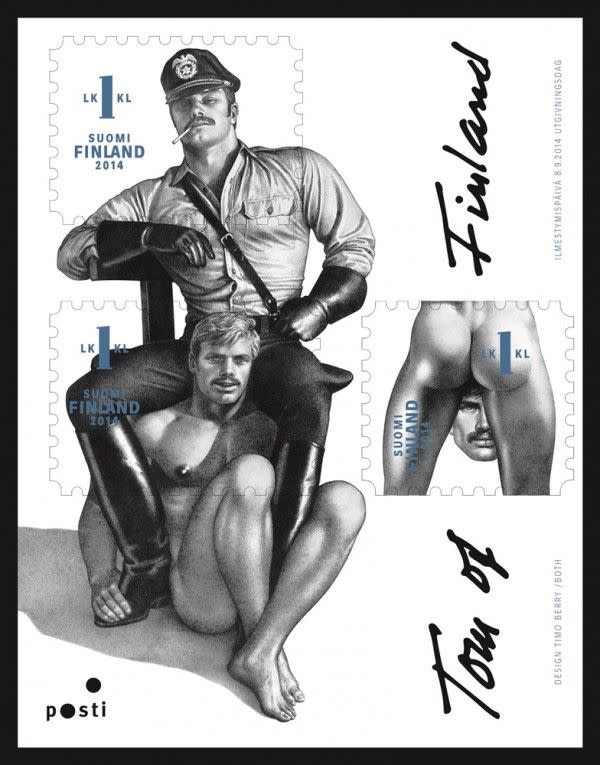There's A Gay Porno Stashed In Your Wardrobe: The History Behind Pride 2020's Best Collab

In 1939, a young Helsinki-based student by the name of Touko Laaksonen had a secret. In-between classes, the 19-year-old sketched what came to him in dreams – the vivid, breathless ones that shock our consciousness when the sun rises – and soon assembled a small archive of "naughty drawings". The naughtiest part being an illegal one: those that came to the artist in his REM-induced euphoria were not young attractive women. They were attractive young men, so muscled and chiselled that they were barely contained in their labourer's uniform, loaf-like hands firmly planted on the smalls of narrow backs, among other places. And yet the dream was abruptly cut short. As global conflict called time on academia, the young Laaksonen was enlisted to fight in the Winter War against the USSR before further deployments in World War 2, and he destroyed all traces of his work. On the surface, the army was not so welcoming of such expression.
It's likely you've never heard of Touko Laaksonen. But you may've seen his work in its purest form, and you've certainly seen it in the epochal wardrobe of Freddie Mercury, and the Village People, and every tweet that refers to a semi-famous handsome man as 'zaddy'. For Laaksonen is more famous by his pen name, a pseudonym that came to define several strands of gay culture before paddling in the mainstream: Tom Of Finland.

Just recently, it was British designer JW Anderson's turn to re-home Finland's landmark work into a limited edition collection to coincide with Pride (another ever-important event placed on ice by Covid-19), and a very important birthday (Tom would've been 100 this year). Anderson himself is a collector of the artist. Though this is no cookie-cutter rainbow-edged 'capsule', or a knee-jerk signal to profess 'allyship' when so many brands fail to even make a contribution to LGBTQ+ charities despite co-opting the flag. This stuff isn't for the sanitised Citibank float, either. Upon felt tote bags and neoprene visors, Tom Of Finland's brigade of burly men are doing what they've always done: tying one another up, refusing shirts, half-smiling as muscles are grabbed and zippers undone. And in comparison to some other works, these are far tamer waters – though a continuation of the designer's penis keyring is not for the pearl-clutcher, with a Tom Of Finlandification of studs and piercings upon black leather, with JW Anderson donating 20 per cent of sales of the signature accessory in all colours to UK Black Pride and LGBTQ+ youth homeless charity Akt.
JW Anderson is one of the few homegrown British designers to command a large fandom with his own name. And this collection, by very token of Anderson's brand capital, is a visible counter to the Disneyfied garb labels cynically peddle. These are pieces plucked from the carnal fringes when Pride began as a riot in response to police raids of the gay-friendly Stonewall Inn. It's authentic, undoctored – even more so as queerness itself only ever did exist on the fringes.
"Even as conversations about sexuality and homosexuality were expanding in the press, gay materials only circulated on the fringes in the mid-twentieth century. Most mainstream discussion of homosexuality presented men as perverts or criminals; at best, they were sad victims," says Dr Justin Bengry, a history lecturer at London's Goldsmiths, and course convenor of the university's Queer History MA programme. "Men who wanted to find gay materials could do so in pulp novels and under-the-counter magazines, but none of this was mainstream. However, the kinds of physique magazines where Tom Of Finland's art was published had a wide distribution among gay men, surpassing by far the reach of activist publications." This meant that American titles like Physique Pictorial – an early proto-porn title to which Finland contributed – were a way to explore intrinsic desires under the heavy cloud of national censorship.

What's more, Tom Of Finland's inkling for the hyper-masculine helped shape gay men's perceptions of self, and those around them. "The image of gay men that dominated mainstream representation at this time was the 'pansy' or the 'sissy'," says Bengry. "He was an object of ridicule and derision, a failed example of masculinity. Tom Of Finland's art showed that men who desired other men could be masculine, virile, and powerful – a response to a culture that so often told gay men they could never be 'real men'."
So masculine are they, that Tom Of Finland's subjects veer on the cusp of sexually-charged caricature. Shoebox jaws aren't the exception; they're the rule. Good looks are essential. Muscles are so big that chests prove almost Olympian, mythological meatheads that openly and unashamedly indulge in behaviour that was only whispered about, keen to enjoy the palpable homoeroticism felt by men who spent months and months together in isolation. Tom Of Finland's subjects were soldiers, and mountaineers, and police officers: there to protect and serve (one another) in a world that decried them. In theirs, 'real men' liked 'real men' too, and delighted in rejecting the traditional use of their ample virility. Undue pleasure, just without the inconvenience of procreation.
JW Anderson isn't the first to pull Tom Of Finland into menswear. While a charitable foundation named after the artist promotes and preserves erotic art in a creative sense (sales of Anderson's collection will raise funds for the organisation too), Scandi textiles outfit Finlayson pinned the more playful images to towels, totes and keyrings, a moustachioed truck driver winking from a reflective bag charm. If you know, you know. Cult underwear label CDLP also partnered with the foundation in 2018, resulting in a collab that was a little more direct, siphoning a portion of proceeds to the foundation. Barely-there briefs were plucked straight from the monochrome sketch of a textbook Tom Of Finlander, in addition to jockstraps (a staple of gay pornography with roots in all-male sport). It was as close to naked as you'd get without shedding the trademark of the artist – which was the point. "I almost never draw a completely naked man, he has to have at least a pair of boots," Finland is well-quoted to having said. "To me, a fully-dressed man is more erotic than a naked one. A naked man is, of course beautiful, but dress him in black leather or a uniform – ah, then he is more than beautiful. Then he is sexy."

Muscle alone did not make Tom Of Finland's brand. It was the clothing. Of course, certain artefacts are still largely shackled to parts of gay cultures: black leather trucker caps, for example, and police shirts so tight they pose an occupational hazard. We don't see them much in heteronormative spaces (which is why the parades of Pride are so important). But is there an element of Finland's cartoonish fixation in the ever-shrinking clothes of Love Island, of oversized glutes crowbarred into suffocating denim? Of men that fawn and gush over the gains of their fellow gym goers? Is Tom Of Finland's refurbishment of masculinity now a lead for men at large? And, are the oversized frames of porn – heterosexual or otherwise – now the norm? It's tempting to connect the dots.
In a community historically mired in deep shame, Tom Of Finland taught many to be ferociously unashamed, to appropriate the uniforms of their oppressors into products of subculture, to out-male the men who told them they weren't enough. That shame endures. Homosexuality was still classed as a mental illness until 1981 in Finland. And, hyper-masculinity has become something of an overarching standard in gay idealism: that to be any lesser is to be sub-par, that to be 'straight passing' is a trophy. This cannot be solely placed at the door of Tom Of Finland, says Bengry. "Today, we might look at these images concerned that they reinforce a 'masc4masc' culture that devalues camp and derides feminine gay and queer men, but in the context of the 1950s and 1960s, Tom Of Finland's images are erotic, playful and subversive."
Tom Of Finland's work isn't flawless. No work is, especially as our window of progressivism actually progresses into a larger, different vision. Nazi uniforms for example, are commonplace in earlier pieces, inspired by Finland's time on the front. The artist vocally condemned its source, saying "the whole Nazi philosophy, the racism and all that, is hateful to me, but of course I drew them anyway – they had the sexiest uniforms!" Which, in itself, is problematic, though Tom Of Finland was quick to state the he believed their designer to be gay too. Placing the kit of a supremacist, gay-hating nation into a sexually charged homoerotic setting could also be seen as the ultimate act of political defiance, too. And, during a time when social progress was barely a mumble in public discourse, Finland's vision has been heralded as an early form of inclusivity by some, with several sketches of Black men and men of colour depicted within his work. These too have faced accusations of hypersexualisation by critics – a racist trope often and wrongly suffered by these very peoples – but supporters champion it as an early form of inclusivity. Everything, after all, in Tom Of Finland's universe is hypersexualised. The controversy still stands.

Ultimately, Finland wanted to illustrate a salvation of sorts. "My drawings are primarily meant for guys who may have experienced misunderstanding and oppression and feel that they have somehow failed in their lives," he said in 1990. "I want to encourage this minority group, to tell them not to give up, to think positively about their act and whole being.” Of course, this took time and an entire ongoing movement that only saw the artist's sexuality decriminalised in own his home country at the grand old age of 61. There's still a long way to go. Though now, there is a wider appreciation of Finland's work. In 2014, three Finnish first class stamps were released celebrating Tom Of Finland – a world first in the mail industry as the first postage stamp to depict homoerotic art. "Pretty risqué" said a Washington Post article at the time. Pretty great, said everyone else, as it became one of the best-selling stamps in the nation's history. He was also the subject of a 2017 feature film that was pitched as the Finnish entry of Best Foreign Language Film at the Oscars. The Academy, then still in the doldrums of out-of-touchness, failed to echo the legion reviews.
And he's also in your wardrobe, too. In JW Anderson and CDLP, yes. But bare chests are back as well. Buttons are to be undone. Perhaps our drowned world of PornHub and OnlyFans and social liberation has desensitised us to such images: we're OK to model our menswear about men who like men because that's chill and we're progressive and we're cool. But Tom Of Finland was doing this before the lights hit green, before lawmakers even acknowledged our existence, and corporations followed suit. Or, perhaps, we're a lot more like a young Touko Laaksonen than we'd think; grappling with fantasies we're told to dispel, cracking padlocked dreams open in art, and clothing, and in Pride, increasingly unafraid of the attractive nightly callers in our dreams.
Like this article? Sign up to our newsletter to get more delivered straight to your inbox
Need some positivity right now? Subscribe to Esquire now for a hit of style, fitness, culture and advice from the experts
You Might Also Like


